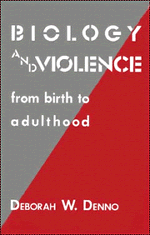Book contents
- Frontmatter
- Contents
- Foreword by Marvin E. Wolfgang
- Preface
- Introduction
- 1 Biological and environmental influences on crime
- 2 Violent criminals as children and as adults
- 3 Intelligence and crime
- 4 Biological and environmental predictors of crime
- 5 Case studies of violent and career criminals
- 6 Biology and responsibility
- Appendix: Selection and distribution of Biosocial Project variables
- References
- Author index
- Subject index
4 - Biological and environmental predictors of crime
Published online by Cambridge University Press: 04 August 2010
- Frontmatter
- Contents
- Foreword by Marvin E. Wolfgang
- Preface
- Introduction
- 1 Biological and environmental influences on crime
- 2 Violent criminals as children and as adults
- 3 Intelligence and crime
- 4 Biological and environmental predictors of crime
- 5 Case studies of violent and career criminals
- 6 Biology and responsibility
- Appendix: Selection and distribution of Biosocial Project variables
- References
- Author index
- Subject index
Summary
What biological and environmental factors predict serious, chronic crime? Although numerous factors have been examined in isolation, few studies have analyzed many key predictors at the same time. The consideration of multiple factors helps to distinguish those variables that simply appear to influence delinquency from those that may have a “real” impact.
The following sections discriminate between weak and strong predictors of juvenile and young adult crime for males and females and then introduce longitudinal models of the strongest effects. Males and females are investigated separately in light of the varying impacts on their delinquent behavior.
Screening of biological and environmental predictors
Over 100 predictors of violent and chronic delinquent behavior (see Table 2.1) were screened for males and females separately using two dependent variables: number of offenses and seriousness of offenses. Variable screening was conducted with three types of regression equations: the forward selection technique, the backward elimination technique, and the stepwise regression – forward and backward.
Those variables found to be significant predictors at the p ≤ .05 level for either sex with either of the two dependent variables are listed in Tables 4.1–4.6. Also in these tables are six variables that were not significant predictors in the regression screening but were included in analyses for theoretical reasons and because they were significant predictors in past research (Stanford–Binet, WISC Verbal and Performance IQ, pregnancy and delivery conditions, and family income at birth and at age 7).
- Type
- Chapter
- Information
- Biology and ViolenceFrom Birth to Adulthood, pp. 70 - 95Publisher: Cambridge University PressPrint publication year: 1990



